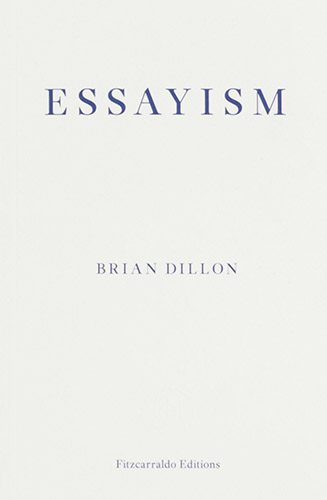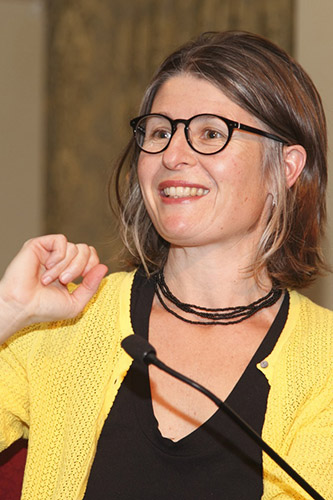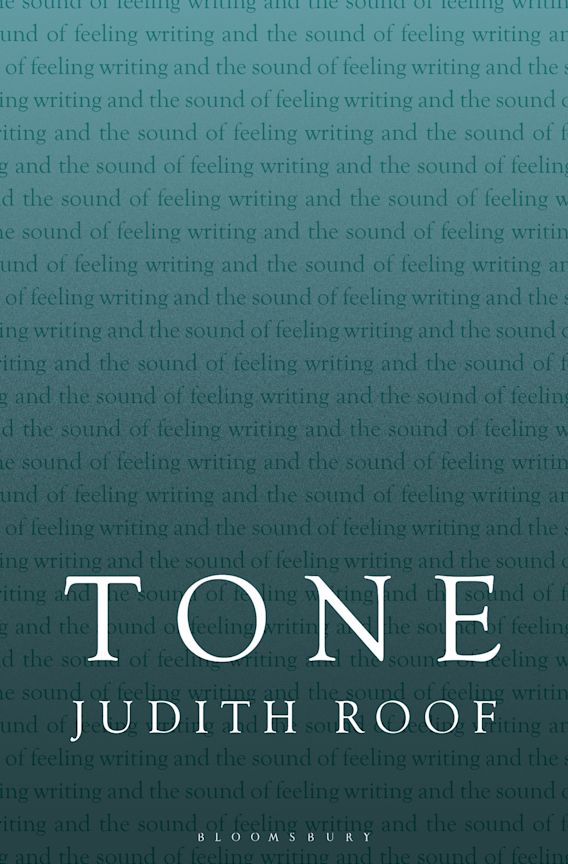In the Dark Room (2005) is Irish writer Brian Dillon’s first book, a memoir of his childhood and early adulthood. Dillon’s mother suffered from two lifelong conditions, one of which killed her. She had depression – severe and unremitting, caused in part by her other condition, scleroderma, a disease which comes with a terrible bouquet of symptoms, including thickening and tightening of the skin, the arteries and veins, and the organs themselves. As the disease progresses, sufferers of scleroderma find it harder and harder to swallow, to breathe, or finally, to move at all. Their oesophagus comes to resemble, and feel like, ‘a glass tube’, the skin of their face, at first as though cosmetically tightened, begins to show lines and then deep lesions like cuts or slices, known as ‘coup de sabre’. The sufferer also experiences Raynaud syndrome, in which blood flow to the extremities is stopped. Dillon’s mother wore gloves to try to keep her hands warm, but also to hide the fact that her hands were becoming like claws. She died when the author was sixteen, leaving him with his father and two younger brothers in a house enclosed in a constricting silence. ‘In the evenings, I retreated to my bedroom. My brothers started to do the same.’ The three brothers did not learn from their restrained, reserved father how to manage or even to talk about grief, and they’d learned only unhappiness from their mother, who used to say that she felt her head would explode – whether from the depression or from the literal pressure of her disease, isn’t entirely clear.
Five years later, and Dillon, still living with his father and brothers, is at university. He wakes one morning, having slept late, to see his brother Kevin at his bedroom door. Kevin is saying something about the police. It takes some moments for his meaning to become clear. Their father is dead, having had a heart attack in the street, ten minutes from their house. Dillon experiences a kind of disbelief, while his body becomes obedient to the new truth: ‘My father is dead. No, my mother is dead (I know, because I was here: I lay here, in this room, on this bed, the morning after she died). But my father is dead too. In a second, I am at the end of the bed, dressing. All I can think is: what do we do now? What exactly are we supposed to do now?’
The boys make arrangements with the undertaker who buried their mother. They return to the house. And now they are alone – alone, but together, until the two younger boys have finished school.
I give all this information about Dillon’s past because it is necessary to know – it is the only way to read this brilliant, unhappy, joyful writer. In the Dark Room was his first full-length book, although he has had a lifetime of working as a writer of essays, criticism and history. Dillon is the Head of Critical Writing in Art and Design at the Royal College of Art in London; he is the UK editor of Cabinet magazine and the essay collection Ruins as well as the author of Tormented Hope: Nine Hypochondriac Lives (2009), a study of illness and imagination, including such diverse subjects as Andy Warhol and Florence Nightingale, and The Great Explosion (2015), a Sebaldian account of an accident at a factory in Kent in the early twentieth century. His latest book, Essayism, was published in 2017.
Of course, given this writing history, In the Dark Room is no ordinary memoir. It isn’t much about the miseries of his mother’s illness, or even about grief – or it is, but it can’t quite bear to be. Instead, it is a meditation on space or spaces, on things, on memory. It attempts what all good books attempt – a kind of lifting off, a swooping away from experience into something we can call joy, or art, or even simply style. Great art does this. It does not reproduce misery; it transforms it. It makes company out of loneliness, living flesh from ashes. Any writer knows that when she is writing at her best she leaves experience in the dust, as dust.
But how can I put this? I found In the Dark Room too depressing. I couldn’t tell – I can’t tell – whether this was a result of my own late brush with depression (I call it a brush, but that’s a trick – I’m trying to trick depression into moving on, leaving me alone) – or whether Dillon had failed. He hadn’t left experience behind. He had reproduced unhappiness. I couldn’t imagine the reader who felt altered for the better by In the Dark Room. Afterwards I could only look away, horrified and sorry for its author, and wishing I had not said I would read his books.
Time passed, and other books intervened, and I privately hoped the editor of this journal would forget that I had promised to write about Essayism. I looked through my little pile of Dillon’s books, but they, too, defeated me. Tormented Lives seemed to be but another anatomy of melancholy, and his novel, Sanctuary, began with a description of a woman succumbing to a migraine. Anyone susceptible to migraines knows how easily they can be called into existence – even the word starts a glittering behind my eyes. I had to put the book away from me, but not before noting that it was written in a style so refined you immediately began to imagine it parodied. I slid the books into the shelf that is behind a doorway in our hall, thinking I wouldn’t need them. I read, in the meantime, a new book by Joan Silber. I read, for the first time, Svetlana Alexievich, and engaged in an excited email exchange about her work with a writing friend. Then, for reasons I can’t recall, I decided to try Proust again.
I’d started Swann’s Way between five and ten times since my late teens, and every time been defeated by it. Adam Gopnik says, ‘Everybody tries to climb Mt. Proust, though many a stiff body is found on the lower slopes, with the other readers stepping over it gingerly.’ Mine was one of the bodies better readers stepped over; it may yet be, as I am still on the first volume of A la recherche du temps perdu. I had no real intention of picking myself up and trying again. It was a long train journey that did it – I thought, I’ll take Swann’s Way and nothing else, then I’ll have no choice but to read it. I’d had success with this method twenty years earlier, reading The Man Who Loved Children on a train between Madrid and Seville.
It was Proust’s sentences that defeated me, all those other times. In the Moncrieff-Kilmartin translation I’m reading some appear to stretch beyond the reader’s vision, their horizon out of reach. I’m sure that’s why I used to panic – halfway through a sentence, and unable to see dry land before or behind me, sometimes having to thrash back to recover the sentence’s subject. But this time, reading on, the backyards of western Sydney flickering past, I started to see that the syntax of the sentences was imitated in the structure of the book itself. That there was art, not just information, at work. That it might be a long time before I saw dry land again, but that it might not matter. I read about dinner at Combray and the profusion of asparagus on the dinner table; there was so much of it this spring. The tips were pale purple and green, and eating them lent a peculiar fragrance to the chamber pot. I read about Aunt Léonie, who took to her bed when her husband died, and who was maintaining a delicate balance between hoping for a recovery that might allow her to come downstairs and even to sit in the garden, and making sure that everyone knew she was dying and would never see the garden again. I read about Aunt Léonie’s maid, Françoise, stumping up and down the stairs with plates of asparagus, which, I later learned, she was serving so frequently not because of the excess of them but in order to torture the little scullery maid who’d got pregnant out of wedlock, and was violently allergic to asparagus. I remember, last time, worrying that I would never be able to retain it all.
But I’ve finally learned to go limp – to float on my back and wait for the rip to take me the slow way home. Who cares if I can’t remember where the Guermantes family live or which church has the hawthorn berries arranged on the altar? The pleasure is in the lostness, the near-drowning in Proust’s unbelievable memory and unbelievably beautiful prose. It’s experimental writing. I never understood this – I’d never got far enough to be able to see that Proust had invented a whole genre, the piling and piling of sentences that somehow imitated memory itself. And I’d never got far enough to enjoy myself.
In Essayism Brian Dillon says that when he became depressed for the second or third time (the only condition he seems to have inherited from his mother) ‘once more I could hardly read at all.’ Depression was not just the ‘drying up of one’s reservoir of symbols and figures for a continued and perhaps even improved life’. It was a cessation of the ability to see ‘symbols and figures’ in other people’s writing. Instead of vistas, a blasted plain; instead of running water, a place where water has never been, nor ever will be. Reading Proust, I am reminded that I am no longer depressed. I lie in bed laughing at the abundance, at the profusion of meanings and images – and laughing at the joyful contemporaneity of reading, allowing me to live alongside Proust, see what he sees, feel what he feels.
And reading is not just joyful but fertile – the bee of my mind buzzes up, laden with pollen, and back to Brian Dillon’s Tormented Lives, to read his chapter on Marcel Proust, who took to his bed just as Aunt Léonie did, but very much more productively. Reading this, and finding life in it, I think perhaps I am ready for Essayism after all.
Essayism is what Martin Amis might describe as a ‘slim vol.’ – a small, beautiful book with an austerely embossed cover and deep gutters around its dense interior text. It did give me a small shiver of horror on approach: there is an ascetism to Dillon’s style (his whole style, I mean, each one of his books, the chilly grip he has on his subject matter, even the look of him in photographs, tall and skinny and white as soap) that could not be more different from Proust’s hilarious luxuriance. But here I would understand that I had not been reading Dillon properly – that previously our meeting as writer and reader had been a meeting of two undertakers, our handshake mutually cold, signifying our agreement that things could never improve. And that perhaps at least one of us needed to be happy for our exchange to be fruitful.
What is Essayism? Its writer admits to us that he has ‘no clue how to write about the essay as a stable entity or established class, how to trace its history diligently from uncertain origins through successive phases of literary dominance’ – and praise be for that. The book is instead a series of attempts, of essays, of course, at delineating or describing the form. Each chapter is a few pages, beginning with an idea: ‘On essays and essayists’, ‘On origins’, ‘On lists’, and as the book begins to become something else, ‘On consolation’. The book is also a story of the book being written, and of Dillon going under entirely. ‘Each day I sat at my desk in an office at the end of the garden,’ he tells us, early on, ‘and cried and smoked and tried to write – tried to write this book – and each day finally gave myself up to fantasies of suicide. I would walk out of this suburb along country lanes to a secluded stretch of railway line and lay my head on the track in the moonlight.’
There is an almost tidal pull towards suicide in Dillon, and Essayism is a story of resisting it. In some chapters he evokes the feeling of being frozen almost at the moment of it, not quite falling, not quite dead, a character swinging cartoon-like in the mid-air beyond a cliff’s edge. He continues working, producing reams of freelance criticism and even another book, telling his psychiatrist that his thoughts of suicide are receding, when ‘In fact I had been sitting down to work each day for years with the conviction that I must kill myself, soon.’ But it would be wrong to suggest that these thoughts and this narrative dominate the book. There is a modesty, a sparingness, a total moral restraint in the way Dillon tells his unhappiness. And what is more – or in fact, because of this – there is art.
Each chapter of this book contains meditations on the work of another, or of many other writers. There is a lesson here about reading, and how deep reading informs the way we think and the way we narrate ourselves. Dillon notices himself using the word ‘parsing’, an expression he first read in an article by the music writer Ian Penman in 1997: ‘It was as though I thought life were something that needed to be defused like a bomb or parsed like an algebraic equation before it could be lived.’ He quotes this line and asks himself, ‘how many times… have I stolen that last phrase in print, or let it pass through my mind as a judgment on myself or others?’ He instinctively understands what literature can be for many of us – a way of thinking ourselves, of describing ourselves to ourselves. In an aside on Henry James and his (hardly unique) inability to write well about sex, he tells us that even that most particular and precise of novelists can ‘end up adverting to a character’s ‘hard manhood’ when that is not what he meant at all.’ Hear that lovely echo of Eliot, like a bell ringing at the end of a street, muffled by distance and habitation.
There are many passages in the book that both describe the work of another writer and then somehow enact it, play it out. Most remarkable of these is a chapter on melancholy, which begins as an examination of the critic Cyril Connolly, and his book The Unquiet Grave, published under the pen-name Palinurus in 1944. The book is ‘an essay, an anthology, a complaint.’ Dillon reads Connolly with us, expressing surprise that he was able to find a publisher for such an odd collection of fragments and quotations and reflections: a collection, we begin to see, not unlike Essayism itself. Dillon notes Connolly’s tendency towards the epigram; for instance: ‘Today an artist must expect to write on water and cast on sand’. The following chapter, another on consolation, describes Dillon’s move to the seaside city of Margate, as his life is coming apart. We see him sleeping on a mattress on the floor, smoking in the basement of his apartment building and riding his bike again and again to the deserted sea front, imagining throwing himself into the water. ‘I never left the flat without feeling that I might blow away in the wind that ceaselessly attacked the town. I would turn into sand or spray.’ The reference to Connolly is there, the connection is made, the art reveals itself, but, as always, quietly, thoughtfully, without fanfare.
What else to tell the reader? In Essayism you will find a list of possible subjects for the essay, drawn from those already written; a list of things the essay might formally be – and might, simultaneously, not be; a story of reading; a collection of closely written passages on sentences, on punctuation; a frankly curious examination of the obsessions of other writers (Thomas Browne, seventeenth-century author of the Pseudodoxica Epidemica, who included in his experiments the trapping of a mole, a viper and a toad under the same glass – the mole, as Dillon tells us, prevailed). Perhaps we should let Dillon, describing the form, describe his own book, which
pursue[s] its adventure by the paradoxical means of an ordered stasis: all its elements arranged as if in a cabinet of curiosities, an elaborate microcosm that freezes in an image some version of the world outside the collection. In this essayistic Wunderkammer, things are allowed to be themselves alone, but will inevitably enter into metaphoric relations with each other, essaying lines of analogy or affinity.
Finally, Essayism is the story of intense unhappiness and the possibility of happiness. It can’t help but speak sometimes of the author’s mother, and her suffering, and the way she transmitted this to her son. It isn’t sentimental; it never tries to pretend that there is a lesson to be learned from this poor woman’s misery, and the misery of her poor sons. Perhaps I might not recommend Dillon’s books to someone who is similarly prone to the contagion of unhappiness; it takes a certain readerly fortitude to resist the dark reasonings of the memoir, the catalogue of miseries that is Tormented Lives. But I am so grateful to have been, at last, the right reader for Essayism. It is Dillon’s life preserver, thrown to himself, and it is joyfully, wonderfully good.







